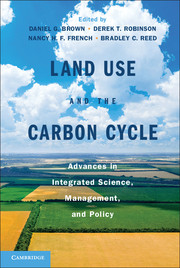Book contents
- Frontmatter
- Contents
- Chapter Authors and Affiliations
- Acknowledgments
- Acronyms
- Part I Introduction
- Part II Measurement and Modeling
- Part III Integrated Science and Research Applications
- 9 Carbon Emissions from Land-Use Change: Model Estimates Using Three Different Data Sets
- 10 A System to Integrate Multiscaled Data Sources for Improving Terrestrial Carbon Balance Estimates
- 11 Simulated Biogeochemical Impacts of Historical Land-Use Changes in the U.S. Great Plains from 1870 to 2003
- 12 Carbon Signatures of Development Patterns along a Gradient of Urbanization
- Part IV Land Policy, Management, and the Carbon Cycle
- Part V Synthesis and Future Directions
- Index
- Plate Section
- References
9 - Carbon Emissions from Land-Use Change: Model Estimates Using Three Different Data Sets
Published online by Cambridge University Press: 05 February 2013
- Frontmatter
- Contents
- Chapter Authors and Affiliations
- Acknowledgments
- Acronyms
- Part I Introduction
- Part II Measurement and Modeling
- Part III Integrated Science and Research Applications
- 9 Carbon Emissions from Land-Use Change: Model Estimates Using Three Different Data Sets
- 10 A System to Integrate Multiscaled Data Sources for Improving Terrestrial Carbon Balance Estimates
- 11 Simulated Biogeochemical Impacts of Historical Land-Use Changes in the U.S. Great Plains from 1870 to 2003
- 12 Carbon Signatures of Development Patterns along a Gradient of Urbanization
- Part IV Land Policy, Management, and the Carbon Cycle
- Part V Synthesis and Future Directions
- Index
- Plate Section
- References
Summary
Introduction
Land-use and land-cover change (LUCC) are an important contributor to emissions of direct (e.g., carbon dioxide [CO2], methane [CH4], and nitrous oxide[N2O]) and indirect (e.g., carbon monoxide [CO], nitrogen oxide [NOx], and nonmethane hydrocarbons) greenhouse gases to the atmosphere. The future projections for atmospheric composition and climate, as well as the associated potential for mitigating emissions and climate change, critically depend on these gases. LUCC has the potential to alter regional and global climate through changes in the biophysical characteristics of the Earth's surface (e.g., albedo and surface roughness) and changes in the biogeochemical cycles of the terrestrial ecosystems (e.g., global carbon [C] and nitrogen [N] cycles). Because of these strong links between LUCC and climate change, historical reconstruction and future projections of LUCC are necessary to better understand climate change.
Estimating the impact of historical LUCC activities on C storage from regional to global scales critically depends on understanding the disturbance history of land. This consists of knowing the current land-cover type, the process used in changing the land to its current land-cover type, and its preconversion land-cover type. Additionally, information about the age of forests, which indicates the maturity, and successional stage of the land are required. Furthermore, the biogeochemical processes and feedbacks adopted to estimate emissions are critically important. For example, it is essential for terrestrial C cycle models to consider the interactions between the terrestrial C and N cycle processes, which are altered not only by changes in LUCC activities but also climate, N inputs, and atmospheric CO2 concentrations (Jain et al. 2009). The uncertainties arising because of these factors hinder our ability to make accurate predictions of changes in the global C cycle and regional and global climate change. This is reflected by the fact that even estimates of the amount of CO2 released to the atmosphere or absorbed by the terrestrial ecosystems for years immediately following LUCC activities have been published with relatively large differences in results (Hurtt et al. 2006; Jain and Yang 2005; Yang, Richardson, and Jain 2010). For example, according to the latest Intergovernmental Panel on Climate Change (IPCC) AR4, CO2 emissions due to LUCC for the 1990s could vary between 0.5 and 2.7 Pg C·yr−1 (median value of 1.6 Pg C·yr−1) (Denman et al. 2007).
- Type
- Chapter
- Information
- Land Use and the Carbon CycleAdvances in Integrated Science, Management, and Policy, pp. 241 - 258Publisher: Cambridge University PressPrint publication year: 2013
References
- 1
- Cited by

